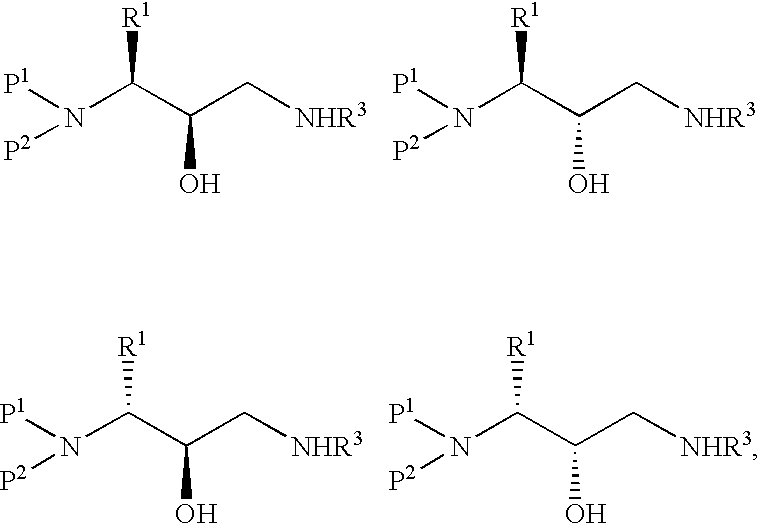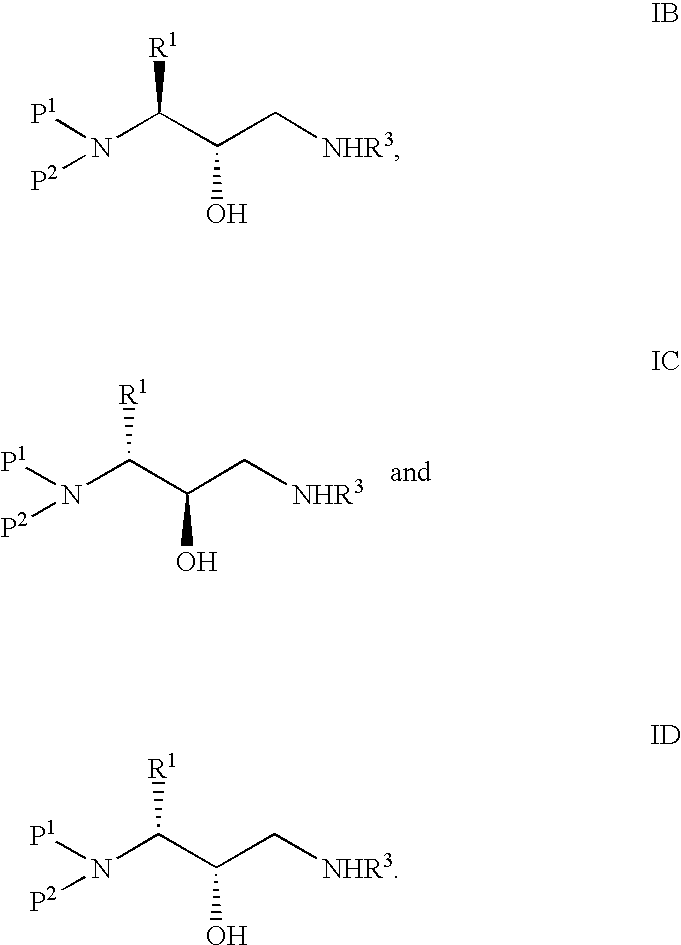Method of preparing retroviral protease inhibitor intermediates
a technology of protease inhibitor and intermediate, which is applied in the field of preparation of intermediates of retroviral protease inhibitors, can solve the problems of difficult and costly synthesis of these compounds, and achieve the effect of improving the synthesis of intermediates
- Summary
- Abstract
- Description
- Claims
- Application Information
AI Technical Summary
Benefits of technology
Problems solved by technology
Method used
Image
Examples
example 1
β-2-[Bis(phenylmethyl)amino]benzenepropanol
METHOD 1:
βS-2-[Bis(phenylmethyl)amino]benzenepropanol from the DIBAL Reduction of N,N-bis(phenylmethyl)-L-Phenylalanine Phenylmethyl Ester
Step 1:
A solution of L-phenylalanine (50.0 g, 0.302 mol), sodium hydroxide (24.2 g, 0.605 mol) and potassium carbonate (83.6 g, 0.605 mol) in water (500 mL) was heated to 97° C. Benzyl bromide (108.5 mL, 0.605 mol) was then slowly added (addition time—25 min). The mixture was stirred at 97° C. for 30 minutes under a nitrogen atmosphere. The solution was cooled to room temperature and extracted with toluene (2×250 mL). The combined organic layers were washed with water and brine, dried over magnesium sulfate, filtered and concentrated to an oil. The identity of the product was confirmed as follows. Analytical TLC (10% ethyl acetate / hexane, silica gel) showed major component at Rf value=0.32 to be the desired tribenzylated compound, N,N-bis(phenylmethyl)-L-phenylalanine phenylmethyl ester. This compound can...
example 2
αS-[Bis(phenylmethyl)amino]benzenepropanaldehyde
METHOD 1:
βS-2-[Bis(phenylmethyl)amino]benzene-propanol (200 g, 0.604 mol) was dissolved in triethylamine (300 mL, 2.15 mol). The mixture was cooled to 12° C. and a solution of sulfur trioxide / pyridine complex (380 g, 2.39 mol) in DMSO (1.6 L) was added at a rate to maintain the temperature between 8-17° C. (addition time—1.0 h). The solution was stirred at ambient temperature under a nitrogen atmosphere for 1.5 hour at which time the reaction was complete by TLC analysis (33% ethyl acetate / hexane, silica gel). The reaction mixture was cooled with ice water and quenched with 1.6 L of cold water (10-15° C.) over 45 minutes. The resultant solution was extracted with ethyl acetate (2.0 L), washed with 5% citric acid (2.0 L), and brine (2.2 L), dried over MgSO4 (280 g) and filtered. The solvent was removed on a rotary evaporator at 35-40° C. and then dried under vacuum to give 198.8 g of αS-[Bis-(phenylmethyl)amino]-benzenepropanaldehyde as...
example 3
N,N,αS-Tris(phenylmethyl)-2S-oxiranemethanamine
METHOD 1:
A solution of αS-[Bis (phenylmethyl)amino]benzenepropanaldehyde (191.7 g, 0.58 mol) and chloroiodomethane (56.4 mL, 0.77 mol) in tetrahydrofuran (1.8 L) was cooled to −30 to −35° C. (colder temperature such as −70° C. also worked well but warmer temperatures are more readily achieved in large scale operations) in a stainless steel reactor under a nitrogen atmosphere. A solution of n-butyl lithium in hexane (1.6 M, 365 mL, 0.58 mol) was then added at a rate that maintained the temperature below −25° C. After addition the mixture was stirred at −30 to −35° C. for 10 minutes. More additions of reagents were carried out in the following manner: (1) additional chloroiodomethane (17 mL) was added, followed by n-butyl lithium (110 mL) at <−25° C. After addition the mixture was stirred at −30 to −35° C. for 10 minutes. This was repeated once. (2) Additional chloroiodomethane (8.5 mL, 0.11 mol) was added, followed by n-butyl lithiu...
PUM
| Property | Measurement | Unit |
|---|---|---|
| optically active | aaaaa | aaaaa |
| organic | aaaaa | aaaaa |
| acid | aaaaa | aaaaa |
Abstract
Description
Claims
Application Information
 Login to View More
Login to View More - R&D
- Intellectual Property
- Life Sciences
- Materials
- Tech Scout
- Unparalleled Data Quality
- Higher Quality Content
- 60% Fewer Hallucinations
Browse by: Latest US Patents, China's latest patents, Technical Efficacy Thesaurus, Application Domain, Technology Topic, Popular Technical Reports.
© 2025 PatSnap. All rights reserved.Legal|Privacy policy|Modern Slavery Act Transparency Statement|Sitemap|About US| Contact US: help@patsnap.com



